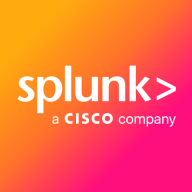

Splunk Enterprise Security and Fortinet FortiSIEM are prominent competitors in the SIEM field. Splunk seems to have the advantage with its sophisticated threat detection and real-time data analysis capabilities, appealing particularly to larger enterprises aiming for deep security insights. Fortinet FortiSIEM, meanwhile, offers a cost-effective, integrated approach and is particularly beneficial for organizations within the Fortinet ecosystem seeking integrated functionalities.
Features: Splunk Enterprise Security offers scalable alerting features, Risk-Based Alerting, and dynamic dashboards, ensuring extensive data visibility and robust integration. Fortinet FortiSIEM is recognized for providing seamless network monitoring, integrating within its product suite, and delivering cost-effective consolidated performance analytics.
Room for Improvement: Splunk's setup complexity, high costs, and steep learning curve are noted areas needing refinement. Users suggest more straightforward setup and better pricing models. Fortinet FortiSIEM could improve on integration with third-party tools, technical support, and update efficiency, with additional feedback on enhancing the user interface and flexibility.
Ease of Deployment and Customer Service: Splunk Enterprise Security supports various deployment models such as on-premises and cloud-based, with generally responsive technical support, although sometimes inconsistent. Fortinet FortiSIEM is praised for simpler deployment and straightforward licensing, though customer service quality varies in response times and expertise.
Pricing and ROI: Splunk Enterprise Security involves premium pricing based on data ingestion volume, making it challenging for smaller organizations, though its comprehensive features often justify the expense for larger enterprises. Fortinet FortiSIEM offers more budget-friendly pricing, aligns well with industry norms, and provides substantial ROI with its integrated security capabilities and fewer additional costs.
The documentation for Splunk Enterprise Security is outstanding. It is well-organized and easy to access.
We couldn't calculate what would have been the cost if they had actually gotten compromised; however, they were in the process, so every investment was returned immediately.
On average, my SecOps team takes probably at least a quarter of the time, if not more, to remediate security incidents with Splunk Enterprise Security compared to our previous solution.
Local tech support is available, however, for more critical or technical issues, we depend on the OEM directly, especially when it comes to on-prem solutions.
There is a knowledgeable, though small, team of support engineers around the world.
They take some time to respond because they need logs and investigations, which delays the response time.
We have paid for Splunk support, and we’re not on the free tier hoping for assistance; we are a significant customer and invest a lot in this service.
I have had nothing but good experiences with Splunk support, receiving timely and helpful replies.
We've had great customer success managers who have helped us navigate scaling from 600 gigs to 30 terabytes.
At any point in time, when network devices increase or there is a change in the infrastructure, we can add more workers and collectors to expand our infrastructure setup.
Fortinet FortiSIEM is highly scalable.
Fortinet FortiSIEM is easy to scale.
We currently rely on disaster recovery and backup recovery, which takes time to recover, during which you're basically blind, so I'm pushing my leadership team to switch over to a clustering environment for constant availability.
They struggle a bit with pure virtual environments, but in terms of how much they can handle, it is pretty good.
It is easy to scale.
It stabilizes itself in an appropriate time, so its uptime is good.
These issues may cause unusual errors and user interface issues.
Some stability issues occur, but Fortinet's technical support team provides assistance.
They test it very thoroughly before release, and our customers have Splunk running for months without issues.
Splunk has been very reliable and very consistent.
It provides a stable environment but needs to integrate with ITSM platforms to achieve better visibility.
Recently, they revised it to a subscription-based, all-inclusive license.
The built-in APIs in Fortinet FortiSIEM are somewhat lacking and could be improved for better integration with external ITSM products.
Fortinet FortiSIEM should broaden its remediation part to include more features for incident management.
Improving the infrastructure behind Splunk Enterprise Security is vital—enhanced cores, CPUs, and memory should be prioritized to support better processing power.
Splunk Enterprise Security is not something that automatically picks things; you have to set up use cases, update data models, and link the right use cases to the right data models for those detections to happen.
For any future enhancements or features, such as MLTK and SOAR platform integration, we need more visibility, training, and certification for the skilled professionals who are working.
Setting it up for oneself as an enterprise-licensed product can be quite expensive.
Windows agent licenses cost around 3,000 Rupees per device per year.
The revised model is subscription-based and more flexible.
I saw clients spend two million dollars a year just feeding data into the Splunk solution.
The platform requires significant financial investment and resources, making it expensive despite its comprehensive features.
I find it to be affordable, which is why every industry uses it.
It provides extensive logging and record-keeping for internal networks, cloud applications, and services as well as perimeter physical network security.
I find the real-time monitoring and correlation capabilities effective for security alerts.
This capability is useful for performance monitoring and issue identification.
I assess Splunk Enterprise Security's insider threat detection capabilities for helping to find unknown threats and anomalous user behavior as great.
Splunk Enterprise Security provides the foundation for unified threat detection, investigation, and response, enabling fast identification of critical issues.
| Product | Market Share (%) |
|---|---|
| Splunk Enterprise Security | 9.2% |
| Fortinet FortiSIEM | 3.3% |
| Other | 87.5% |


| Company Size | Count |
|---|---|
| Small Business | 34 |
| Midsize Enterprise | 21 |
| Large Enterprise | 23 |
| Company Size | Count |
|---|---|
| Small Business | 110 |
| Midsize Enterprise | 50 |
| Large Enterprise | 257 |
FortiSIEM (formerly AccelOps 4) provides an actionable security intelligence platform to monitor security, performance and compliance through a single pane of glass.
Companies around the world use FortiSIEM for the following use cases:
Splunk Enterprise Security delivers powerful log management, rapid searches, and intuitive dashboards, enhancing real-time analytics and security measures. Its advanced machine learning and wide system compatibility streamline threat detection and incident response across diverse IT environments.
Splunk Enterprise Security stands out in security operations with robust features like comprehensive threat intelligence and seamless data integration. Its real-time analytics and customizable queries enable proactive threat analysis and efficient incident response. Integration with multiple third-party feeds allows detailed threat correlation and streamlined data visualization. Users find the intuitive UI and broad compatibility support efficient threat detection while reducing false positives. Despite its strengths, areas such as visualization capabilities and integration processes with cloud environments need enhancement. Users face a high learning curve, and improvements in automation, AI, documentation, and training are desired to maximize its potential.
What Are the Key Features of Splunk Enterprise Security?In specific industries like finance and healthcare, Splunk Enterprise Security is instrumental for log aggregation, SIEM functionalities, and compliance monitoring. Companies leverage its capabilities for proactive threat analysis and response, ensuring comprehensive security monitoring and integration with various tools for heightened operational intelligence.
We monitor all Security Information and Event Management (SIEM) reviews to prevent fraudulent reviews and keep review quality high. We do not post reviews by company employees or direct competitors. We validate each review for authenticity via cross-reference with LinkedIn, and personal follow-up with the reviewer when necessary.